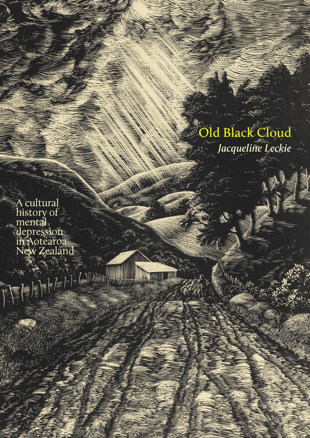Emma Jean-Kelly reviews Old Black Cloud: A culture history of mental depression in Aotearoa New Zealand for New Zealand Journal of Public History:
‘Dr T.G. Gray, the newly appointed Director-General of New Zealand’s Mental Hospitals Department, arrived from Scotland in 1911 and noted the ‘singularly isolated position which the mental hospitals occupied in the public life of the country … [T]heir drab and dreary structure and routine symbolised the hopelessly pessimistic attitude of the public towards the prognosis of those who had to be admitted’.
Jacqueline Leckie’s historical analysis begins 60 years before Gray’s observations, and her work offers a foundational history of (largely) state-based asylum care over the next century and more. While politicians wring their hands today as they discuss the new reports tabled in Parliament from the Royal Commission of Inquiry into Abuse in Care, rhetorically asking how abuse in care could possibly have happened, Leckie demonstrates how, almost from its inception, the state system designed to support people in mental distress was vulnerable to the vagaries, fashions and dispositions of those in charge, and the ‘hopelessly pessimistic’ attitudes of the general public towards mental health issues.
That Leckie’s history of mental depression was published in the same year as the final report of the years-long royal commission feels appropriate. It helps us contextualise the long history of isolation which has at times characterised institutional care in this country. But it also offers ‘glimpses of the lives of those admitted to’ those institutions, as well as the attitudes of those who administered and managed them, as Barbara Brookes has argued in relation to paperwork from the files of Seacliff Asylum.
Alexander McKinnon’s family history, Come Back to Mona Vale, offers a companion piece to Leckie’s work, a detailed case study to complement her overview. Leckie mentions the unusual story of McKinnon’s grandfather, Tracy Gough, a successful businessman who was also the purveyor of an early electric shock treatment machine. Electric shock treatment was used on his own daughter in a private hospital after a sibling had died of an overdose of cardiazol and repeated high doses of paraldehyde, both administered at Christchurch’s Sunnyside Hospital in 1941. Chillingly, paraldehyde and unmodified electric shock treatment both featured in the (now officially acknowledged) torture of young people at Lake Alice, near Marton, in the 1970s, as outlined in one of the Abuse in Care reports.
While to some this may be unfamiliar territory, Leckie very generously begins with her own experience of depression. It is reasonably unusual for a Pākehā historian to offer her personal story, and this is a way to frame the topic, offering a contemporary point connection for the reader. It also opens up one of the themes of the book, women’s experience of mental illness. Leckie’s experience of depression does not seem dissimilar to many of the case studies she describes, but her treatment has been very different.
The high-energy entertainer and celebrant Pinky Agnew spoke at the Wellington launch of the book. It became clear that Agnew was involved not just because she is an old friend of Leckie, but also because she has her own experience of depression. But most centrally, her grandmother is the subject of one of the more intimate case studies in the book. Agnew explained that as a young child she was getting milk out of the fridge when her mother mentioned she was going to visit her own mother at Seacliff Mental Hospital in Otago. Agnew described the milk splashing upwards out of the jug as she jumped in shock at this revelation. To her later shame, she was too embarrassed to visit her grandmother, who lived the last 52 years of her life in asylums. Her grandmother was Jane Dick, educated and trained as a nurse, who came to New Zealand from Scotland as a war bride. She suffered post-natal depression while living in an isolated part of Otago Peninsula. One day Jane took her son and baby daughter out for a walk, heading for a cliff, and it was only the intervention of a neighbour which persuaded her not to walk herself and both children over the edge. Having Agnew tell this story at the book launch, with further detail offered in Leckie’s book, reminds the reader once more that this history is neither long ago nor far away.’
Read the rest of the review here.


